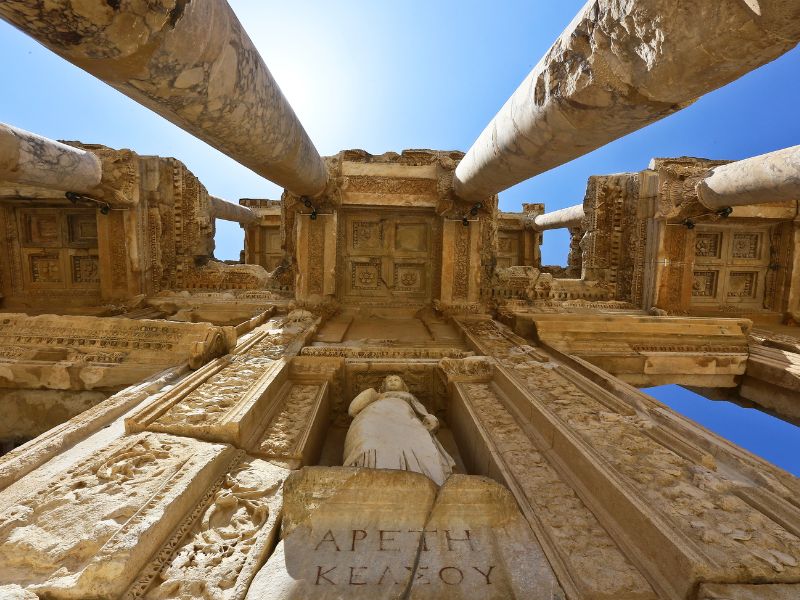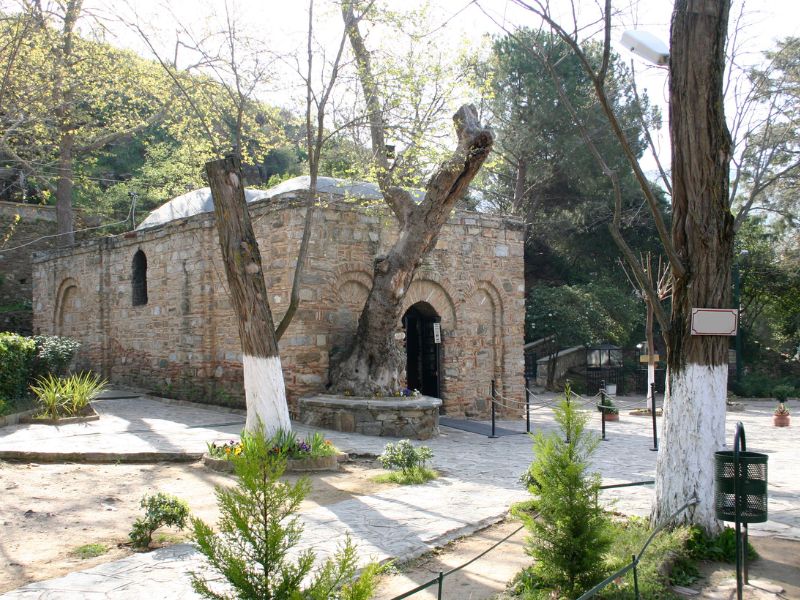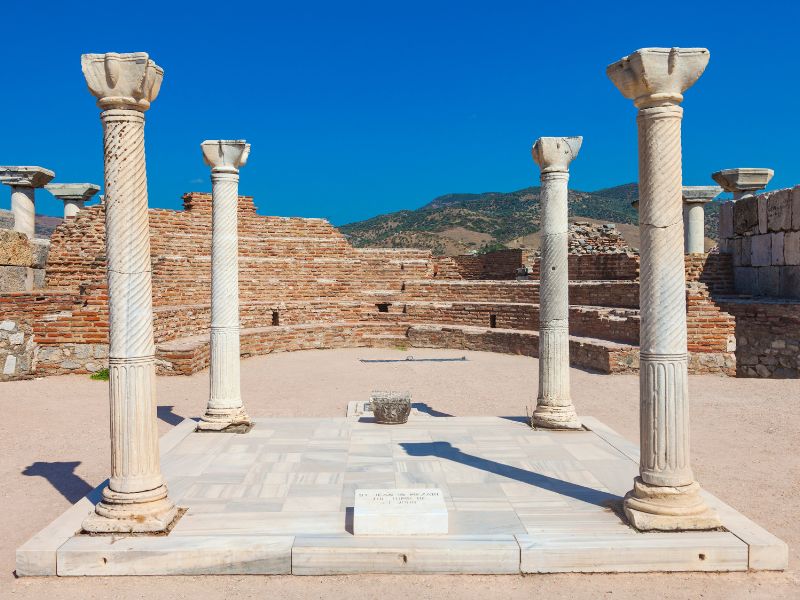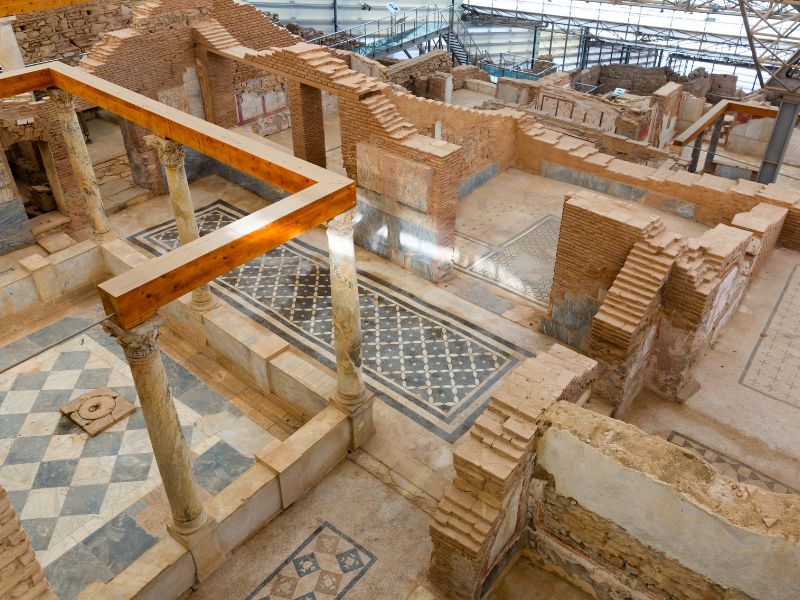Introduction
Ephesus, an ancient city renowned for its extensive ruins and rich history, offers a treasure trove of experiences for history enthusiasts and travelers. Situated in what is now modern-day Turkey, Ephesus was once a bustling hub of commerce, religion, and culture.
Beyond its famed ancient ruins, several nearby attractions provide deeper insights into the region’s historical and cultural significance. This guide to Archaeological Sights of Ephesus explores four must-visit locations near by: the House of the Virgin Mary, the Basilica of St. John, Sirince Village, and the Ephesus Archaeological Museum.
The ancient city of Ephesus

Ephesus stands as one of the most important cities of the ancient world. Founded by the Greeks and later expanded under Roman rule, it was home to the Temple of Artemis, one of the Seven Wonders of the Ancient World.
With this guide of Archaeological Sights of Ephesus through city’s extensive ruins offer a glimpse into its storied past, making it a premier destination for history buffs and travelers alike.
Exploring the Mystical House of the Virgin Mary

Historical Background and Significance
The House of the Virgin Mary holds a unique place in Christian tradition. According to legend, this sacred site is where Mary, the mother of Jesus, spent her final years. Discovered in the 19th century based on the visions of Anne Catherine Emmerich, it has since become a revered pilgrimage destination.
Visitor Experience and Must-See Spots
Visitors to the House of the Virgin Mary will find a modest stone structure surrounded by serene gardens. Key highlights include:
- The Chapel: A small chapel within the house serves as a place of worship and reflection.
- The Wishing Wall: Visitors can leave notes and prayers on this wall, a tradition that adds a deeply personal touch to the visit.
- Holy Water Fountain: Believed to have healing properties, this fountain is a popular spot for visitors to collect holy water.
How to Get There and Practical Tips
The site is located a short drive from Ephesus. Visitors can either opt for a guided tour or hire a taxi from Selçuk, the nearest town. Practical tips for a memorable visit include:
- Best Time to Visit: Early morning or late afternoon to avoid crowds.
- Dress Code: Modest attire is recommended, respecting the site’s religious significance.
- Accessibility: The site is wheelchair accessible, though some areas may require assistance.
Uncovering the Basilica of St. John in Ephesus

Historical Background and Significance
The Basilica of St. John is an architectural marvel that dates back to the 6th century AD. Commissioned by Emperor Justinian I, this basilica was constructed over the believed burial site of St. John the Apostle, one of Jesus’s disciples and the author of the Book of Revelation.
The basilica’s construction highlights the significance of Archaeological Sights of Ephesus as a major center for early Christianity and provides a poignant connection to the early days of the faith.
Architectural Features and Visitor Highlights
The Basilica of St. John, although mostly in ruins today, offers visitors a fascinating glimpse into early Byzantine architecture. Key features and highlights include:
- The Tomb of St. John: Central to the basilica, this revered site is believed to be the final resting place of St. John, attracting numerous pilgrims.
- The Baptistery: Located to the west of the basilica, this octagonal-shaped structure was used for baptisms and is notable for its intricate design.
- The Frescoes and Mosaics: Although many have faded over time, remnants of the original frescoes and mosaics provide insight into the artistry and religious symbolism of the era.
Visitor Experience and Practical Tips
Exploring the Basilica of St. John is a journey through time, offering an enriching experience for history enthusiasts and religious pilgrims alike. Some practical tips for your visit include:
- Best Time to Visit: Early morning or late afternoon to avoid the heat and crowds.
- Guided Tours: Hiring a knowledgeable guide can greatly enhance your understanding of the site’s historical and religious importance.
- Preservation and Respect: As with all historical sites, visitors are encouraged to respect the preservation efforts by not touching fragile structures or artifacts.
- Photography: While photography is allowed, using a camera’s flash is discouraged to protect the ancient frescoes and mosaics.
Visiting the Basilica of St. John offers an unforgettable journey into one of Christianity’s most sacred sites, providing a deeper understanding of the spiritual heritage and historical significance of Ephesus.
Sirince Village – A Hidden Gem

Introduction to the Charming Village
Located in the hills near Ephesus, Sirince Village is known for its scenic beauty and traditional charm. Originally settled by freed Greek slaves, the village retains a unique blend of Turkish and Greek influences.
Unique Experiences and Attractions
Sirince offers a variety of experiences that appeal to different interests:
- Wine Tasting: Renowned for its local wines, visitors can enjoy tastings at numerous family-run wineries.
- Traditional Houses: Explore the well-preserved traditional stone houses that line the village streets.
- Artisan Shops: Discover handmade crafts and local products in the village’s quaint shops.
Suggestions for Exploring the Village
To make the most of your visit to Sirince, consider these tips:
- Walking Tour: Wear comfortable shoes and explore the village on foot to fully appreciate its charm.
- Local Cuisine: Don’t miss out on tasting local delicacies such as gozleme (Turkish pancakes) and olive oil-based dishes.
- Souvenir Shopping: Purchase unique souvenirs like handwoven textiles and local olive oil.
The Treasures of Archaeological Sights of Ephesus: Ephesus Archaeological Museum

Overview of the Museum’s Collection
The Ephesus Archaeological Museum houses a vast collection of artifacts unearthed from the ancient city of Ephesus and surrounding areas. The museum provides a comprehensive look at the region’s historical and cultural evolution.
Highlights of Must-See Exhibits
Key exhibits in the museum include:
- Statue of Artemis: A magnificent statue of the Ephesian Artemis, representing the goddess’s unique cult.
- Socrates Room: The Socrates Room in the Ephesus Archaeological Museum displays artifacts from the Hellenistic and Roman periods, named after the philosopher Socrates. Highlights include philosophical inscriptions, busts and statues of notable figures, and artifacts from ancient libraries and schools. This exhibit illustrates the profound impact of Greek philosophy on Ephesus’s cultural and intellectual life.
- Terrace House Frescoes: Beautiful frescoes recovered from the Terrace Houses of Ephesus.
Visitor Tips for Making the Most of Your Visit
To maximize your museum experience, keep the following in mind:
- Guided Audio Tours: Available in multiple languages, these enhance the visitor experience with detailed descriptions.
- Time Allocation: Plan for at least two hours to explore the museum thoroughly.
- Photography: While photography is allowed, be mindful of no-flash zones to preserve delicate artifacts.
Conclusion
The Basilica of St. John and nearby attractions in Ephesus, such as Sirince Village and the Ephesus Archaeological Museum, provide valuable insights into the region’s rich history and culture. These sites reflect early Christianity’s architectural and spiritual significance, alongside Greek and Roman influences.

